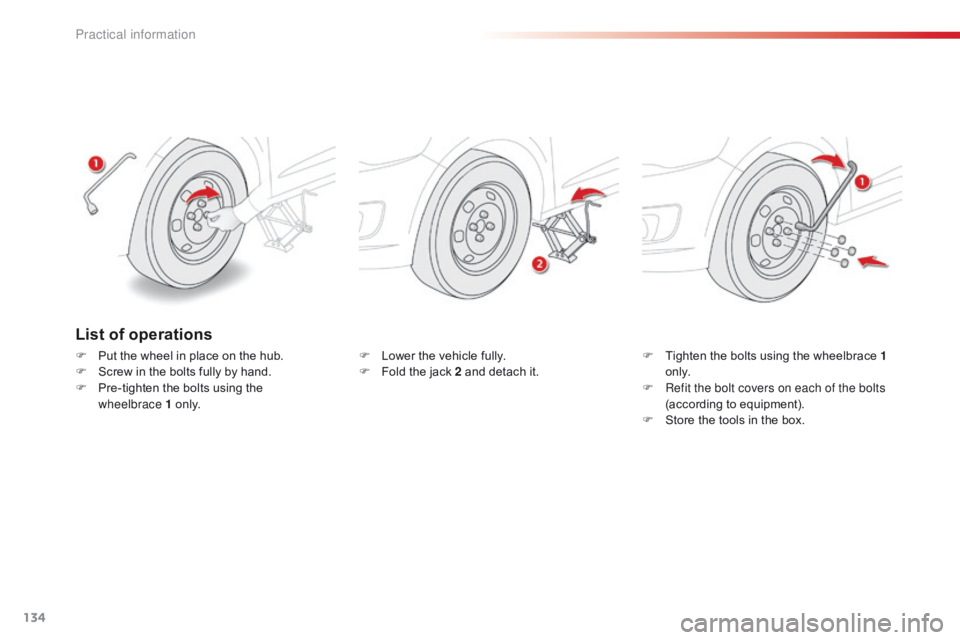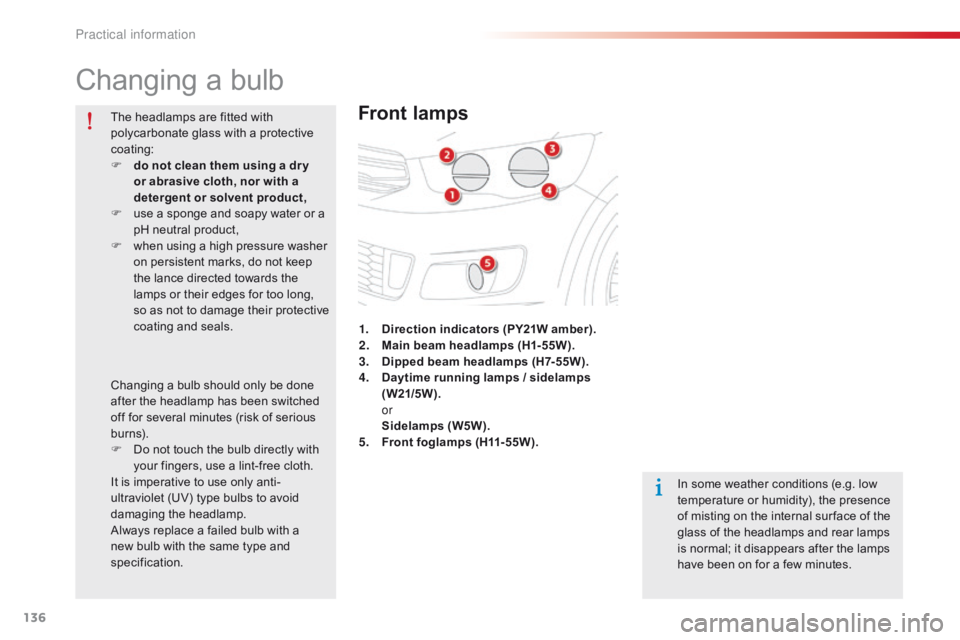CITROEN C-ELYSÉE 2015 Owners Manual
Manufacturer: CITROEN, Model Year: 2015, Model line: C-ELYSÉE, Model: CITROEN C-ELYSÉE 2015Pages: 285, PDF Size: 13.42 MB
Page 131 of 285

129
Wheel with trim
When refitting the wheel, refit the trim
starting by placing its notch facing the
valve and press around its edge with
the palm of your hand.
The spare wheel is installed in the boot under
the floor.
Spare wheel (depending on version)
Taking out the wheel
F Unscrew the yellow central bolt.
F R aise the spare wheel towards you from
the rear.
F
T
ake the wheel out of the boot.
F
U
nclip the tool storage box by pulling on it.
9
Pr
Page 132 of 285

130
Putting the wheel back in place
F Clip the tool storage box back into place.
F
P
ut the wheel back in its housing.
F
U
nscrew the yellow central bolt by a few
turns then put it in place in the centre of the
wheel.
F
T
ighten fully until the central bolt clicks to
retain the wheel correctly.
Practical information
Page 133 of 285

131
Removing a wheel
Parking the vehicle
Immobilise the vehicle where it does not
block traffic: the ground must be level,
stable and not slippery.
Apply the parking brake, switch off the
ignition and engage first gear* to block
the wheels.
Check that the parking brake warning
lamps in the instrument panel come on.
The occupants must get out of the
vehicle and wait where they are safe.
Ensure that the jack is correctly
positioned at one of the vehicle's
jacking points.
Incorrect use of the jack could cause
the vehicle to drop.
Never go underneath a vehicle raised
using a jack; use an axle stand.
List of operations
F Remove the bolt cover from each of the bolts using the tool 3 (according to
equipment).
F
S
lacken the bolts using the wheelbrace 1
o n l y.
Do not use:
-
t
he jack for any other purpose than
lifting the vehicle,
-
a j
ack other than the one supplied
by the manufacturer.
*
P
osition R for an electronic gearbox; P for
an automatic gearbox.
9
Practical information
Page 134 of 285

132
F Place the foot of the jack 2 on the ground and ensure that it is directly below the
front A or rear B jacking point provided on
the underbody, whichever is closest to the
wheel to be changed. F
E xtend the jack 2 until its head comes into contact with the jacking point A or B used; the
vehicle’s contact sur face at A or B must engage with the central part of the head of the jack.
F
R
aise the vehicle until there is sufficient space between the wheel and the ground to admit the
spare (not punctured) wheel easily.
Practical information
Page 135 of 285

133
F Remove the bolts and store them in a clean place.
F
R
emove the wheel.Ensure that the jack is stable. If the
ground is slippery or loose, the jack
might slip or drop - Risk of injury!
Take care to position the jack only at
one of the vehicle’s jacking points A
or
B under the vehicle, ensuring that the
contact sur face of the vehicle’s jacking
point is centred on the head of the jack.
Other wise there is a risk of damage to
the vehicle and/or that the jack might
drop - Risk of injury!
Fitting a wheel
Fitting the spare wheel
If your vehicle is fitted with alloy wheels,
when tightening the bolts on fitting, it is
normal to notice that the washers do not
come into contact with the spare wheel.
The wheel is secured by the conical
sur face of each bolt.
After changing a wheel
To store the punctured wheel in the
boot correctly, first remove the central
c ove r.
Have the tightening of the bolts and the
pressure of the spare wheel checked
by a CITROËN dealer or a qualified
workshop without delay.
Have the punctured wheel repaired
and refitted to the vehicle as soon as
possible.
9
Practical information
Page 136 of 285

134
F Lower the vehicle fully.
F F old the jack 2 and detach it. F
T ighten the bolts using the wheelbrace 1
o n l y.
F
R
efit the bolt covers on each of the bolts
(according to equipment).
F
S
tore the tools in the box.
List of operations
F Put the wheel in place on the hub.
F S crew in the bolts fully by hand.
F
P
re-tighten the bolts using the
wheelbrace
1 o n l y.
Practical information
Page 137 of 285

135
Snow chains
In wintry conditions, snow chains improve traction as well as the behaviour of the vehicle when
braking.Advice on installation
F If you have to fit the chains during a journey, stop the vehicle on a flat sur face
on the side of the road.
F
A
pply the parking brake and position any
wheel chocks to prevent movement of your
vehicle.
F
F
it the chains following the instructions
provided by the manufacturer.
F
M
ove off gently and drive for a few
moments, without exceeding 30 mph
(50
km/h).
F
S
top your vehicle and check that the snow
chains are correctly tightened.
Use only the chains designed to be fitted to the
type of wheel fitted to your vehicle:
Original tyre size Maximum link size.185/65 R15 9 mm
195/55 R16
For more information on snow chains, contact a
CITROËN dealer or a qualified workshop.
It is strongly recommended that before
you leave, you practise fitting the snow
chains on a level and dry sur face. Avoid driving with snow chains on roads
that have been cleared of snow, to
avoid damaging your vehicle's tyres and
the road sur face. If your vehicle is fitted
with alloy wheels, check that no part of
the chain or its fixings is in contact with
the wheel rim.
Take account of the legislation in force
in your country on the use of snow
chains and the maximum running speed
authorised.
The snow chains must be fitted only
to the front wheels. They must never
be fitted to "space-saver" type spare
wheels.
9
Practical information
Page 138 of 285

136
Changing a bulb
Front lamps
In some weather conditions (e.g. low
temperature or humidity), the presence
of misting on the internal sur face of the
glass of the headlamps and rear lamps
is normal; it disappears after the lamps
have been on for a few minutes.
The headlamps are fitted with
polycarbonate glass with a protective
coating:
F
d
o not clean them using a dr y
or abrasive cloth, nor with a
detergent or solvent product,
F
u
se a sponge and soapy water or a
pH neutral product,
F
w
hen using a high pressure washer
on persistent marks, do not keep
the lance directed towards the
lamps or their edges for too long,
so as not to damage their protective
coating and seals.
Changing a bulb should only be done
after the headlamp has been switched
off for several minutes (risk of serious
burns).
F
D
o not touch the bulb directly with
your fingers, use a lint-free cloth.
It is imperative to use only anti-
ultraviolet (UV) type bulbs to avoid
damaging the headlamp.
Always replace a failed bulb with a
new bulb with the same type and
specification. 1.
D
irection indicators (PY21W amber).
2.
M
ain beam headlamps (H1-55W).
3.
D
ipped beam headlamps (H7-55W).
4.
D
aytime running lamps
/ sidelamps
(W21/5W).
or
S
idelamps (W5W).
5.
F
ront foglamps (H11-55W).
Practical information
Page 139 of 285

137
Amber coloured bulbs, such as the
direction indicators, must be replaced
with bulbs of identical specifications
and colour.
When refitting, close the protective
cover carefully to preserve the sealing
of the headlamp.
Rapid flashing of the direction indicator
warning lamp (right or left) indicates the
failure of a bulb on that side.
Changing direction indicator
bulbs
F Turn the bulb holder an eighth of a turn
anti-clockwise and extract it.
F
R
emove the bulb and change it.
To reassemble, carry out these operations in
reverse order.
Changing main beam headlamp
bulbs
F Remove the protective cover by pulling on the tab.
F
D
isconnect the bulb connector.
F
P
ush the spring to one side to release the
bulb.
F
R
emove the bulb and change it.
To refit, carry out these operations in reverse
o r d e r.
9
Practical information
Page 140 of 285

138
Changing dipped beam
headlamp bulbs
F Remove the protective cover by pulling
the tab.
F
D
isconnect the bulb connector by lifting
it
off.
F
P
ull the bulb out and change it.
To refit, carry out these operations in reverse
o r d e r.
Changing daytime running lamp /
s idelamp bulbs
F Pull the bulb holder pressing on the tabs on
both sides.
F
R
emove the bulb and change it.
To refit, carry out these operations in reverse
o r d e r.
Practical information